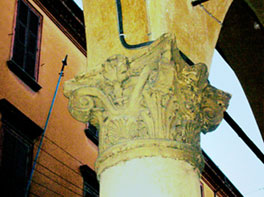|



 |
Napoleon's arrival upset the economic order. The land
market which substituted industrial activity, transformed Bologna into a
big agrarian province.
Architecture was in decline.
At the end of the 18th Century, after the splendour
of Cardinal Lambertini and General L.F. Marsili
(Sciences Institute founder) times, the city which had 70,000
inhabitants, experienced a stagnant period. The Senate managed to block
the land and tax reform planned by cardinal Boncompagni. On June 19th 1796
the Napoleonic Army of Italy arrived in Bologna and received a warm
welcome. This new situation gave rise to a revival of the University and
economic life. The return of church estates, ordered by Napoleon, produced
a radical change to the economy and generated a
land market - introduction of capitalism in the country - that upset the
previous order and transformed the industrial city in a huge land
province. Within this context, after the Reno deviation to the sea, the
proposal of a Cavo (Basin), which would be called Napoleonic to link the
Reno to the Big Po, was approved by Napoleon. Today the Cavo is useful
should the Reno overflow. Bologna belonged to the Cispadane Republic
between 1796 and 1799; to the New Cisalpine Republic between 1799
and 1801, to the Republic than the Kingdom of Italy between 1802 and 1815.
It even seemed that in 1814-15 Bologna was the capital of an independent
State of four legations. The name of Antoine Aldini, State secretary of
the Napoleonic Kingdom of Italy stood out The neoclassic Aldini Villa,
which dominated the city from the hill, was built against the church della
Madonna del Monte (XII cent) by the Napoleonic Minister Antonio Aldini, in
memory of a place where Napoleon had praised the city.
Accompanying the studies reform in a
scientific direction, the seat of the university moved from the
Archiginnasio to Poggi Palace where the Marsili's Science Institute was
already. In the area surrounding poggi Palace the campus began to form.
The transfer of the University seat from the Archiginnasio to Poggi Palace
was another consequence of the Napoleonic regime and the initiatives of
Bolognese Jacobinism. Poggi Palace (in 1803, during the period of the
Italian Republic, which succeeded the Napoleonic Rule of Italy) was chosen
because it already housed the Science Institute, created by Luigi
Ferdinando Marsili at the beginning of the 18th Century, and was not
included in the University; this Institute contained rich collections of
scientific equipment; (at present all this material is kept in the
Library, in the Marsili and Aldrovandi Museums, all of them housed in the
Poggi Palace). So surrounding Poggi Palace, the area was to become the
centre of the study district so with the Botanic Garden near the ancient
Bentivoglian Palazzina della Viola, the "study town" or "campus", as it
would be called in the future, began to form isolating the students from
the town life. The importance given to scientific disciplines, during the,
Napoleonic period, which followed the 18th Century extra official or
iIIuministic tradition, towards the end of the 19th century resulted in
the great Bolognese positivist school.
|
|
b
o
l
o
g
n
a
u
r
b
a
n
p
l
a
n
|
